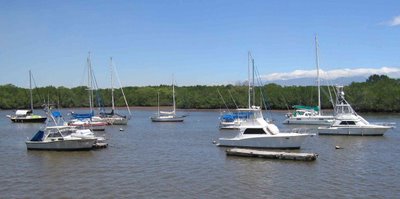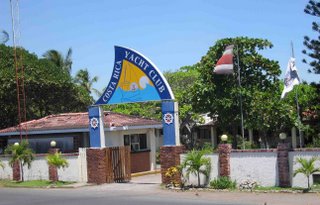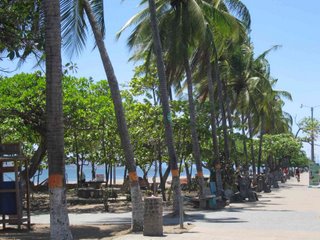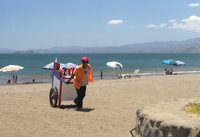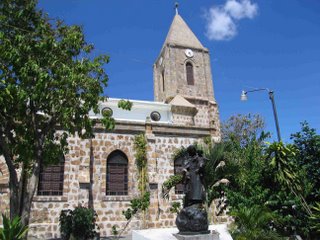As we headed further south from La Fortuna and the mountainous cloud forest region, clearing skies contrasted with the large banks of cloud which continued to envelope the areas around the Arenal volcano. We saw more scenic beauty from the bus windows all the way to San José. From the top of the mountain ridge overlooking the Central Valley we had excellent views
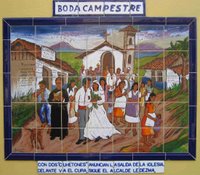
of the valley,
San José and its neighbouring cities as well as the Gulf of Nicoya on the distant Pacific coast.
One convenience I’ve used on several visits to San José is the combined Internet café and Laundromat, in the centre of the city close to Gran Hotel Costa Rica. This we used the following day, in spite of the frustration of having to use computer keyboards with numerous punctuation keys which did not correspond with their key symbols. The rest of the day we spent generally sightseeing on foot – Mercado Central, Parque de España, Parque Morazón (with its large gazebo, the “Music Temple”), Parque Nacional,
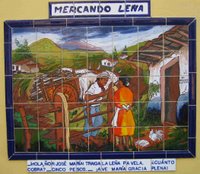
National Legislative Buildings, etc. On the walls of a cosy hotel in a nice residential area near the National Botanical and Zoological gardens was a series of about eight or nine interesting ceramic tile murals depicting aspects of traditional Costa Rican life. Late in the afternoon, we saw and heard the very animated swarming of the large numbers of green parakeets in the Parque Central, an event repeated each dusk.
Following the quashing of a revolution in 1948, the Costa Rica legislature took the revolutionary step of disbanding the national army. The headquarters of the army, the Old Fort (Bellavista
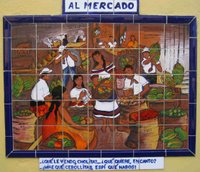
Barracks), being no longer required for military purposes, was later refurbished and turned into the National Museum. Bullet holes from the 1948 revolution can still be seen in many of the exterior walls. Carol and I spent a few
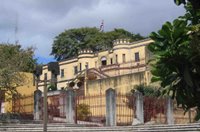
hours seeing its exhibits and learning a bit about Costa Rican history, from the early indigenous and Pre-Columbian times through the colonial era to the present.
Particularly interesting were the displa
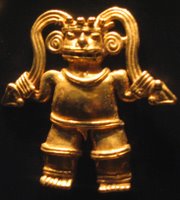
ys of gold and jade ornaments and figurines, pottery and ceramics, and the many ornate varieties of three legged ceremonial “tables” carved in stone. Lithic spheres, or stone balls carved out of hard granite by the early Di

quis tribe of south-western Costa Rica, are also on display in various sizes. These spheres have been found in diameters up to six feet and weighing several tons. Their purpose is still unknown.

The large inner courtyard of the museum was attractively landscaped with tropical trees, shrubs, cacti, old cannons, some lithic sphe

res and a collection of old coffee bean processing machinery. The surrounding tiled galleries contained old colonial wooden benches and potted plants.



A day excursion trip from San José seemed like a good idea, so we caught a couple of connecting local buses to the artisan village of
Sarchí, Costa Rica’s most important crafts centre abo
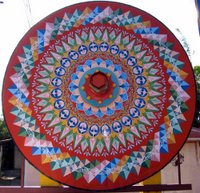
ut 30 km from the capital. Sarchí is particularly well known for its highly decorative traditional wooden oxcarts (carretas). Last November, UNESCO declared these traditional oxcarts part of the world’s intangible herita

ge. They came from Spanish colonial tradition, and the designs are believed to have originated in Andalucia. Being originally working carts used by the campesinos for transporting all sorts of cargo, they became a form of expression when painted and decorated with increasingly colourful and intricate designs.

The centre of Sarchí is dominated by a church described by one guide book as being of a “birthday cake” design. We found one of the larger artisan markets nearby, with a greatly oversized representation of the decorative wheel of a traditional oxcart in the forecourt
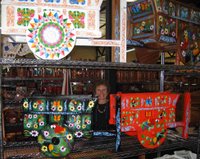
. The market itself had on display numerous colourfully painted oxcarts of various sizes – the smaller sizes being simply souvenirs. There was also a huge volume of

craftwork intended for the tourist market, such as colourful plaques, pictures, masks, wood carvings, decorative hardwood boxes, hand-painted feathers, necklaces and numerous other souvenirs.
The hilly countryside around Sarchí is very scenic. Just below the artisans’

market was a restaurant which overlooked part of the

surrounding gardens. On display at the entrance to the restaurant, much as a tourist venue in Canada might have a wooden carved Indian chief, was one of the colourful

oxcarts, complete with matching ox yokes. However, there were no oxen in attendance.

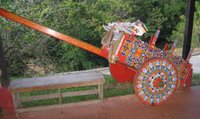 Puerto Viejo de Talamanca
Puerto Viejo de Talamanca, on the Caribbean coast, was our next destination. We checked into a nice beachside hotel a short (according to Carol) walk outside of the centre of the village, to the east. It was the

last of the series of beachside accommodations along the dirt road leading out of Puerto Viejo, in a very nice location surrounded by forest. The sound of the surf was ever present and it was only a fe

w paces from our door to the beach. It was very peaceful and well out of earshot of the hustle and bustle of the centre of this tourist village (Carol tells me).
It was getting to be late in the afternoon, and close to refreshment time. As an alternative to the bumpy dirt road with its trucks and bikes, we walk
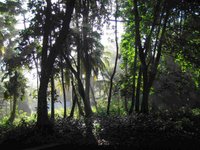
ed back to the village along the trail through the trees, just above the beach. Puerto Viejo is not very big. It has a main street and a parallel secondary main street beside the beach, plus numerous dirt sidestreets. Accommodations for all b

udgets are available in and around the village. Puerto Viejo and some of the nearby beaches have been becoming increasingly popular with the surfing crowd. So young people with boards were very visible segment of the tourist crow
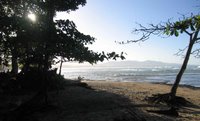
d.
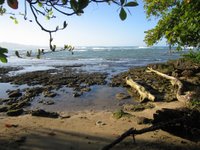
I had good memories of an excellent lunch I’d had at a Thai restaurant when I was last in Puerto Viejo last September. So Carol and I thought that we would forgo rice and beans just this once to try something different.
Chile Rojo is owned and operated by Andrew Bacon, an Englishman, and his Japanese partner Ikuko Nagasaka. Andrew lived in Thailand for a
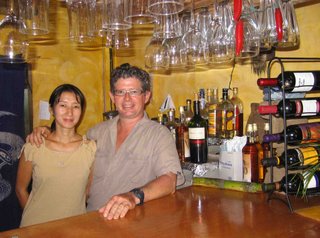
while, where he studied the local cuisine. He obviously studied it well, because the memories of my great September meal were equalled, or even surpassed.
It’s exceptional for me to review meals I’ve had, but my tastebuds were so scintillated by my meals in
Chile Rojo that I can’t hold back. If you find yourself in
Chile Rojo, the first item you should choose from the menu is the Thai fish & coconut soup with rice noodles, lemon grass and chile, which also includes a perfectly cooked julienne of vegetables. This cost 2,000 colones (about US$4.00) plus 13% tax. Also superb was the Thai green curry with coconut milk, lemon grass, kaffir lime leaf & mixed vegetables, and rice and chicken, for 3,200 colones plus tax. I enjoyed two varieties of this dish on two occasions. It also comes with fish instead of the chicken, or, for 3,000 colones, there is a vegetarian version. Carol also enjoyed the Thai tofu sesame salad, with rice noodles, lettuce, julienne vegetables & Thai peanut dressing, for 2,000 colones plus tax. Now look what I’ve done – my mouth is watering.

We ate at a couple of other restaurants in the village but concluded that we were wasting our dining budget by not working our way through
Chile Rojo’s menu at lunch and dinner times.
The panc

ake and fruit salad breakfast by the beach at Parquecito Cove (near the centre of the village) the following morning was good preparation for our rental bike ride along the bumpy dirt road to Manzanillo. However, a few big bags of pancake mix strapped to the bike seat would have offered some protection from the potholes. The dirt road follo
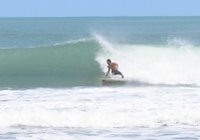
ws the line of the beach all the way (about 12 kms) to
Manzanillo, although narrow to wide bands of forest separate the two.
Playa Cocles was our first pause. It has a beautiful palm tree fronted beach and reputedly offers some of the best surfing on the Caribbean coas

t. I’m not qualified to comment on that, but we did watch several surfers trying to confirm the claim. We pushed our pedals onwards towards Punta Uva, where we took a muddy pooled side road from the main dirt road through the trees to the waterfront. Another beautiful palm lined beach by the po

int - ideal for all the things people like to do on beaches.

Back a short way from the beach and through the trees was a sort of jungle resort bar/restaurant,
Ranchito, located perfectly for much needed refreshment. Several small palapas, designed to cover individual tables, were scattered around the grounds in the
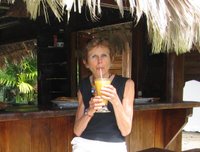
general vicinity of the thatch covered main palapa. It was an Italian restaurant operated by an Italian couple, whose small son, Eduardo, was charming some of the customers.
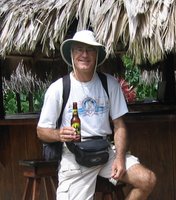
Continuing on towards Manzanillo on the bumpy road, I was

using the bike seat less and less, preferring to reduce discomfort by standing on the pedals. I expect that a tropical tree and shrub expert would have been in top gear identifying all the exotic varieties we were riding past. But there was one distinctive flowering plant I was able to subseque

ntly identify – the Heliconia plant.
Manzanillo is on the edge of the Refugio Nacional Gandoca-Manzanillo, an extremely rich and diversified ecological environment with over 5,000 hectares of land and over 4,400 hectares of ocean, which extends to the border with Panama. Reefs stand off the shore along most of this stretch of coastline, including off the beach at Manzanillo. Rain forest makes up over 65% of the park, which also includes wetlands and a rare red mangrove tree swamp.

Unfortunately, we would have needed much more time than we had available in order to explore the park.
On our return ride back to Puerto Viejo, on the veranda of a roadside resta
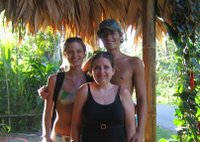
urant where we stopped for drinks, we encountered a young trio of siblings we had met earlier. We had earlier all been looking for accommodation at the same time, having arrived in Puerto Viejo on the same bus. Their home was in Victoria, BC. Gary had been travelling in Costa Rica and his sisters, Nikki and Carleen, had joined him for a short visit. San José was next on their itinerary, where they were

going to meet up with their parents who were flying from Canada to join them. They were excellent representatives of their generation and we had a very enjoyable chat. One of the more pleasant aspects of travel is meeting nice young people such as these three.
We explored the trails by the beach on both sides of the village the following day, including another visit to Playa Cocles, and generally took it easy. After a disappointing breakfast at a restauran

t we hadn’t tried before, we avoided a repeat of that mistake by returning to
Chili Rojo for our remaining meals of the day. My mouth is watering just thinking about it.
Cahuita is only about half an hour by bus from Puerto Viejo, to the north west. After a leisurely late breakfast the following morning, we took the 11:30 am bus to Cahuita and checked in to Cabinas Safari, close to the centre of the village. We exp

lored the village from the park entrance on one side to Playa Negra on the other during the afternoon, and filled in some of the time doing essential things such as buying T-shirts (Carol), having a beer (me), doing e-mail (Carol), having a beer (me), etc.
We had arranged to have dinner that evening at an Italian restaurant w

ith Ed and Doreen, a lively English born Canadian couple we had met at lunch time. Our first mistake was not taking with us our plastic rain ponchos. It began to rain as we walked to the restaurant and then the heavens opened shortly after we arrived and we were entertained by the loud noise of a tropical downpour for most of the time we were having dinner. Fortunately, it eased off by the time we were ready to leave.
Our second mistake was having control of our budget pre

-empted, as our individual orders (we all ordered the same meal) were then combined into a joint order, followed by our companions adding more ingredients. They then added further dishes which also ended up on our share of the bill. It was a nice meal but overpriced for what it was.
 Cahuita National Park
Cahuita National Park was our reason for being in Cahuita. The park was set aside in 1970 and became a National Park in 1978. The land area, part of which is on a small peninsula, covers 1,068 hectares. Included also in the park are 600 hectares of coral reefs and a total of 22,400 hectares of marine area. The coral reef is the most developed and important on the Costa Rica Caribbean coast, and contains about 35 species of coral. The land area is home to howler and white face monke
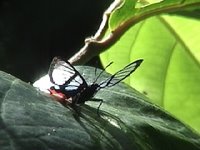
ys, sloths, and coatimundis, among others, as well as a wide variety of birds such as toucans and hummingbirds.
Carol still hadn’t seen
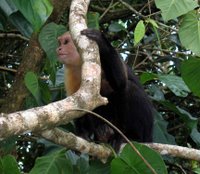
a monkey during her visit. We were counting on Cahuita to fill the bill. And we weren’t disappointed. We entered the park at about 08:00 am and walked along the beachside trail. The tide was quite high and was washing over the trail in places. At one spot where a creek runs across the path from a small lagoon into the sea I had to remove my shoes and wade across.
There was much activity going on around our feet – crawlin
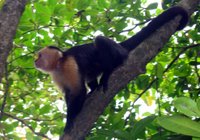
g hermit crabs, numerous ghost crabs darting for cover down their holes, lines of marching load-carrying leaf cutter ants, lots of small lizards and geckos, and a large green lizard with prehistoric looking fins on its head and back. Butterflies fluttered, including

the blue morpho and the glass winged butterfly. Later, near the exit, there was a viper hiding in the brush and a large gold thread spider in its web waiting for dinner.
But the monkeys were the stars of the show. Carol finally got her wish. First, I saw one isolated white face capuchin monkey high in the branches. Not far away, we came across a group of them resting high in the trees. Not much move

ment. After watching them for a short while, we walked further down the path. About 5 minutes later, we saw another group of capuchin monkeys on the trail ahead of us. They then came bounding down the trail towards us without any concern for our presence. They paused at times and then continued until several of them had scrambled near and past us, taking positions on low branches and looking around in utmost seriousness.
Perhaps they had become

accustomed to getting tidbits from visitors to the park. Feeding the monkeys is strongly discouraged by the park rangers. One problem is related to the bad effects this has on the health of the monkeys. Many things they are given by misguided tourists are not natural food sources for these monkeys. The internal damaging effects can sometimes be seen externally in the change in colour of the normally white portions of their fur, which turns yellow or darker. Rangers have reported on the increase of sickness in some groups.

Giving food which is not necessarily foreign to their natural diet, such as certain fruits, is also harmful to them as it changes their behaviour patterns and potentially disrupts their social structure. For example, proffering a piece of fruit can result in several monkeys fighting over it. Monkeys can also get aggressive towards humans when they are not given tidbits they have come to expect. There is abundant food for the monkeys in the forest without them having to fight for it. They have all they need. Tourists are told not to endanger the

monkeys for their own entertainment.
In

addition to my month touring Costa Rica last autumn, I had been in the country about 2½ months at this point. During that time, I had heard on many occasions the distinctive sound of howler monkeys. But I’d never seen one. I don’t think tha
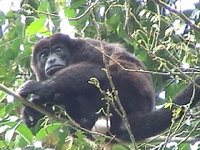
t they are particularly shy, but they have been elusive to me. I thought that this was going to continue when Carol and I heard a couple of groups of howler monkeys having a howling contest. As the dialogue continued not far away, we tried spotting the source of one side of the argument. Clear loud howling emitted but only trees could be seen. However, on walking further towards the second
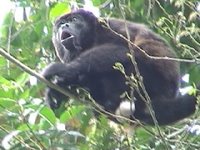
protagonist, we came upon the entire tribe in the trees above our heads.
I managed to get some decent video sequences, taking advantage of the power of the zoom lens on the camcorder. I’ve copied a series of still frames from the video. After the glowering first frame (“Who are you looking at?”), the series shows “the boss” in full throated howl. The group ranged from mature to infant, with two or three of the little ones having fun play wrestling. It was a
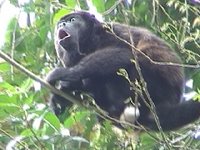
great way to close our visit to the park.
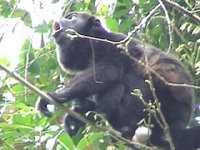
Next morning it was time for the return visit to San José. It had rained heavily all night but it eased off by the time we got on the 07:30 bus. But that didn’t last. The bus ploughed through lots of

rain and heavy low level cloud and fog for much of the way back to the Central Valley. We had a very brave driver who probably spends much of his spare time in casinos. He had no fears when overtaking on double yellow lines or blind curves. Nor did he worry about keeping his foot on the accelerator when the visibility ahead in the heavy fog dropped down to about 10 feet. But once we got
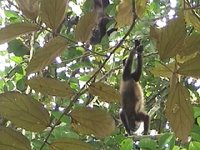
onto the valley side of the mountain ridge, the weather cleared up and it was partly sunny as we entered San José.
Lunch and shopping, including a visit to the Artisans’ Market (where Carol drove some hard bargains), filled our time before catching the 14:30 hrs bus to Puntarenas. Back to the Pacific coast heat, refreshment at the Yacht Club was called for.
For Carol’s final day in Costa Rica, a Saturday, we r
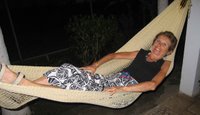
elaxed and explored a bit of beachside Puntarenas along the Paseo de los Turistas and around the end of the peninsula. The 07:30 bus the following morning would get Carol to the airport near Alajuela in good time for her afternoon flight back to Vancouver.
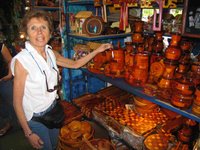
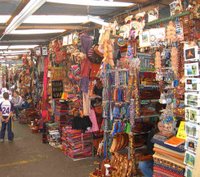
We both enjoyed our whirlwind tour to some of the highlights of Costa Rica. The convenience and reasonable cost of the excellent network of buses made travelling through the country pleasant and easy. And although the security of one’s personal property is always an issue when travelling in Costa Rica, I didn’t feel quite as tense about it as I had when I toured the country last September. Perhaps I’d adapted and became more accustomed to the situation.
 Puntarenas is on a long narrow peninsula in the Gulf of Nicoya, Costa Rica. The estuary on its north shore (left) is shallow and boats accessing the Costa Rica Yacht Club may only enter or leave close to the rising high tide. This is quite an old photo, and does not show the "new" jetty. To the right is the beach fronting on the Gulf of Nicoya. Skirting that beach is the Paseo de Turistas.
Puntarenas is on a long narrow peninsula in the Gulf of Nicoya, Costa Rica. The estuary on its north shore (left) is shallow and boats accessing the Costa Rica Yacht Club may only enter or leave close to the rising high tide. This is quite an old photo, and does not show the "new" jetty. To the right is the beach fronting on the Gulf of Nicoya. Skirting that beach is the Paseo de Turistas. 